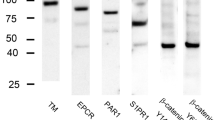Abstract
Rickettsiae of the spotted fever group are obligately intracellular bacteria that primarily infect the vascular endothelium, invade adjacent cells propelled by actin polymerization, and cause severe systemic diseases. Endothelial dysfunction and vascular leakage develop as a consequence; this effect is the pathophysiological mechanism that explains most clinical manifestations. Here we report that rickettsial infection of cultured primary human endothelial cells is associated with the formation of gaps in the interendothelial adherens junctions, occurring late during the course of in vitro infections but not early, even when rickettsial loads are significant.

Similar content being viewed by others
References
Aurrand-Lions M, Johnson-Leger C, Imhof BA (2002) Role of interendothelial adhesion molecules in the control of vascular functions. Vasc Pharmacol 39:239–246
Del Maschio A, Zanetti A, Corada M, Rival Y, Ruco L, Lampugnani MG, Dejana E (1996) Polymorphonuclear leukocyte adhesion triggers the disorganization of endothelial cell-to-cell adherens junctions. J Cell Biol 135:497–510
Dudek SM, Garcia JG (2001) Cytoskeletal regulation of pulmonary vascular permeability. J Appl Physiol 91:1487–1500
Gimbrone MA Jr, Cotran RS, Folkman J (1974) Human vascular endothelial cells in culture. Growth and DNA synthesis. J Cell Biol 60:673–684
Gouin E, Egile C, Dehoux P, Villiers V, Adams J, Gertler F, Li R, Cossart P (2004) The RickA protein of Rickettsia conorii activates the Arp2/3 complex. Nature 427:457–461
Heinzen RA (2003) Rickettsial actin-based motility: behavior and involvement of cytoskeletal regulators. Ann N Y Acad Sci 990:535–547
Heinzen RA, Hayes SF, Peacock MG, Hackstadt T (1993) Directional actin polymerization associated with spotted fever group Rickettsia infection of Vero cells. Infect Immun 61:1926–1935
Jeng RL, Goley ED, D’Alessio JA, Chaga OY, Svitkina TM, Borisy GG, Heinzen RA, Welch MD (2004) A Rickettsia WASP-like protein activates the Arp2/3 complex and mediates actin-based motility. Cell Microbiol 6:761–769
Kaplanski G, Teysseire N, Farnarier C, Kaplanski S, Lissitzky JC, Durand JM, Soubeyrand J, Dinarello CA, Bongrand P (1995) IL-6 and IL-8 production from cultured human endothelial cells stimulated by infection with Rickettsia conorii via a cell-associated IL-1 alpha-dependent pathway. J Clin Invest 96:2839–2844
Lampugnani MG, Ejana E (1997) Interendothelial junctions: structure, signalling and functional roles. Curr Opin Cell Biol 9:674–682
Reed LJ, Muench H (1938) A simple method of estimating fifty percent endpoints. Am J Hyg 27:493–497
Sahni SK, Van Antwerp DJ, Eremeeva ME, Silverman DJ, Marder VJ, Sporn LA (1998) Proteasome-independent activation of nuclear factor kappaB in cytoplasmic extracts from human endothelial cells by Rickettsia rickettsii. Infect Immun 66:1827–1833
Sahni SK, Rydkina E, Joshi SG, Sporn LA, Silverman DJ (2003) Interactions of Rickettsia rickettsii with endothelial nuclear factor-kappaB in a “cell-free” system. Ann N Y Acad Sci 990:635–641
Sporn LA, arder VJ (1996) Interleukin-1 alpha production during Rickettsia rickettsii infection of cultured endothelial cells: potential role in autocrine cell stimulation. Infect Immun 64:1609–1613
Sporn LA, Sahni SK, Lerner NB, Marder VJ, Silverman DJ, Turpin LC, Schwab AL (1997) Rickettsia rickettsii infection of cultured human endothelial cells induces NF-kappaB activation. Infect Immun 65:2786–2791
Walker DH (1995) Rocky Mountain spotted fever: a seasonal alert. Clin Infect Dis 20:1111–1117
Walker DH (2002) Rickettsia rickettsii: as virulent as ever. Am J Trop Med Hyg 66:448–449
Walker DH, Cain BG (1980) The rickettsial plaque. Evidence for direct cytopathic effect of Rickettsia rickettsii. Lab Invest 43:388–396
Walker DH, Raoult D (2000) Rickettsia rickettsii and other spotted fever group rickettsiae (rocky mountain spotted fever and other spotted fevers). In: Mandell GL, Bennett JE, Dolin R (eds) Principles and practice of infectious diseases. Churchill Livingstone, New York, pp 2035–2042
Walker DH, Bouyer DH (2003) Rickettsia. In: Murray PL, Baron EJ, Jorgensen JH, Pfaller MA, Yolken RH (eds) Manual of clinical microbiology. ASM Press, Washington, pp 1005–1014
Acknowledgements
We thank Susan Butler for her assistance with preparation of the manuscript. Sources of support: NIH grant RO1 AI21242 to David H. Walker.
Author information
Authors and Affiliations
Corresponding author
Rights and permissions
About this article
Cite this article
Valbuena, G., Walker, D.H. Changes in the adherens junctions of human endothelial cells infected with spotted fever group rickettsiae. Virchows Arch 446, 379–382 (2005). https://doi.org/10.1007/s00428-004-1165-3
Received:
Accepted:
Published:
Issue Date:
DOI: https://doi.org/10.1007/s00428-004-1165-3




